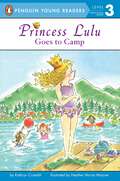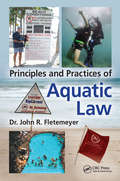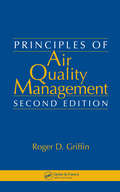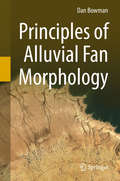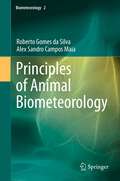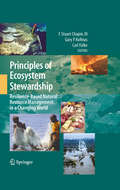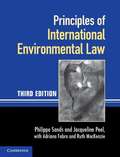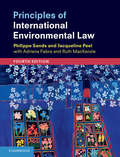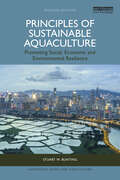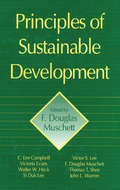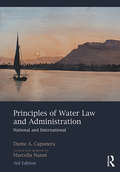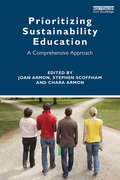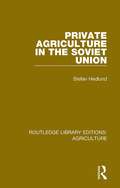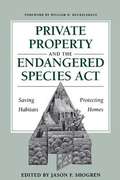- Table View
- List View
Princess From Another Planet
by Mindy SchanbackFourteen-year-old Gracie Wright escapes her impoverished and unconventional life by impersonating her rich cousin at an exclusive summer camp, until a series of weird events convinces her that her mother's delusions about being the deposed queen of a distant planet just might be true.
Princess Lulu Goes to Camp (Penguin Young Readers, Level 3)
by Kathryn CristaldiLulu is a princess. She has everything--well, almost everything. Princess Lulu doesn't have any friends. Will she finally find a friend at Camp Ruff 'n' Tuff? Find out in this Level 3 reader!
Principal Component Regression for Crop Yield Estimation
by T. M. V. Suryanarayana P. B. MistryThis book highlights the estimation of crop yield in Central Gujarat, especially with regard to the development of Multiple Regression Models and Principal Component Regression (PCR) models using climatological parameters as independent variables and crop yield as a dependent variable. It subsequently compares the multiple linear regression (MLR) and PCR results, and discusses the significance of PCR for crop yield estimation. In this context, the book also covers Principal Component Analysis (PCA), a statistical procedure used to reduce a number of correlated variables into a smaller number of uncorrelated variables called principal components (PC). This book will be helpful to the students and researchers, starting their works on climate and agriculture, mainly focussing on estimation models. The flow of chapters takes the readers in a smooth path, in understanding climate and weather and impact of climate change, and gradually proceeds towards downscaling techniques and then finally towards development of principal component regression models and applying the same for the crop yield estimation.
Principles and Practices of Aquatic Law
by John Robert FletemeyerPrinciples and Practices of Aquatic Law presents the best practices and principles related to aquatic law and risk management. Its focus is injury and death occurring in aquatic environments including the ocean, pools, water parks, canals, rivers, lakes, dams, etc. It discusses the importance of aquatic risk management as it relates to aquatic accident prevention and the concept of duty and liability for a facility’s management and staff. It also presents updated and relevant information about beach safety and the importance of hazard identification, warning, and elimination, and provides information for attorneys relating to the process of developing liability theories involving serious aquatic accidents and death. Features Presents a comprehensive resource on the applied practices and principles of aquatic law. Provides information for attorneys for the process of developing liability theories involving serious aquatic accidents and death. Presents updated and relevant information about beach safety and the importance of hazard identification, warning, and elimination. Discusses water-borne contaminants such as cryptosporidium and flesh-eating bacteria. Presents comprehensive public safety and beach management strategies: rip current prediction and monitoring, coastal engineering, drowning and rescue statistics, etc.
Principles for Building Resilience
by Biggs, Reinette and Schlüter, Maja and Schoon, Michael L. Reinette Biggs Maja Schlüter Michael L. SchoonAs both the societies and the world in which we live face increasingly rapid and turbulent changes, the concept of resilience has become an active and important research area. Reflecting the very latest research, this book provides a critical review of the ways in which resilience of social-ecological systems, and the ecosystem services they provide, can be enhanced. With contributions from leaders in the field, the chapters are structured around seven key principles for building resilience: maintain diversity and redundancy; manage connectivity; manage slow variables and feedbacks; foster complex adaptive systems thinking; encourage learning; broaden participation; and promote polycentric governance. The authors assess the evidence in support of these principles, discussing their practical application and outlining further research needs. Intended for researchers, practitioners and graduate students, this is an ideal resource for anyone working in resilience science and for those in the broader fields of sustainability science, environmental management and governance.
Principles of Air Quality Management
by Roger D. GriffinBlending information from popular mainstream articles, highly technical publications, and research journals, the second edition of Principles of Air Quality Management features new sections on air toxics, new information on chronic and acute health effects, and new approaches to the assessment of those impacts on sensitive populations. It em
Principles of Alluvial Fan Morphology
by Dan BowmanThis book offers a comprehensive overview of the alluvial fan phenomena, including all terminology, morphology, sedimentology, controlling factors, processes and the human impact. It combines the knowledge dispersed widely in existing literature with regional case studies, color figures and photographs. The chapters provide a useful basis to understand alluvial fans and a selection of papers attached to each chapter offers additional, more focused reading. This volume is aimed at engineers, planners and especially students in earth sciences.
Principles of Animal Biometeorology
by Roberto Gomes da Silva Alex Sandro Campos MaiaThe book begins by describing in detail the mechanisms of energy exchange - radiative, convective, conductive and evaporative - together with techniques for their determination. The discussion extends to the importance of CO2, ozone and methane, together with that of aerosol pollutants and the evolution of atmospheric CO2. Subsequent chapters apply the results of the biophysical methods to mammals, birds and aquatic animals. Discussion includes problems of shelter and shade for animals in tropical environments and techniques for the thermal evaluation for shelters and for several tree types. The details of heat exchange between animals and the environment are presented, in separate chapters covering Mammals and Birds and Aquatic Mammals. A chapter on Shade and Shelter describes the importance of shade for animals, factors of shade efficiency, the protections offered by shelter and methods of calculating the protection afforded by both shade and shelter. A Special Methods chapter offers a variety of techniques for evaluating cutaneous and respiratory evaporation, and practical methods for sampling of hairs and the evaluation of hair coat characteristics.
Principles of Ecosystem Stewardship
by Gary P. Kofinas M. C. Chapin F. Stuart Chapin III Carl FolkeThis is a textbook for Natural Resource Management, Resource Conservation and Ecosystem Management, as well as other related or more specialized courses. Most textbooks on natural resource and ecosystem management are dominated by a steady-state view that interprets change as gradual and incremental and disregards interactions across scales. Management implementation of steady-state theory and policies tends to invest in controlling a few selected ecosystem processes, at the expense of long-term social-ecological resilience - i.e., the capacity of the system to cope with surprise and abrupt changes. Loss of resilience makes systems more vulnerable to both expected and unforeseen changes. Achieving desirable outcomes for humanity, such as those of the UN Millennium Development Goals on poverty, food security, and environmental sustainability, will require new integrated and adaptive approaches to social and economic development, where the complex interconnectedness between humans and nature, at all scales, is considered and the existence of uncertainty and surprise accepted as the rule. The purpose of this textbook is to provide a new framework for resource management - a framework based on the necessity of managing resources in a world dominated by uncertainty and change. The book links recent advances in the theory of resilience, sustainability, and vulnerability with practical issues of resource management.
Principles of International Environmental Law
by Philippe Sands Jacqueline Peel Adriana Fabra Ruth MackenzieThe third edition of this classic textbook offers comprehensive and critical commentary on international environmental law. It fully covers the key topics of the course and is clearly structured to include the history and framework in which international environmental law exists, key areas of regulation and implementation, links to other areas of law and future developments. It has been updated to incorporate all the latest developments in treaty and case law. Extensive feedback on previous editions results in a restructuring of material, including a new part focused on linkage to other areas of international law including human rights, international trade and foreign investment. There is also a new chapter on future developments charting the directions in which the subject is moving. Specialist authors writing on oceans, seas and fisheries and biodiversity add to the expertise of the two principal authors for an authoritative overview of the subject.
Principles of International Environmental Law: Frameworks, Standards, And Implementation (Studies In International Law)
by Philippe Sands Jacqueline Peel Adriana Fabra Ruth MacKenzieThis new and fully updated edition of Principles of International Environmental Law offers a comprehensive and critical account of one of the fastest growing areas of international law: the principles and rules relating to environmental protection. Introducing the reader to the key foundational principles, governance structures and regulatory techniques, Principles of International Environmental Law explores each of the major areas of international environmental regulation through substantive chapters, including climate change, atmospheric protection, oceans and freshwater, biodiversity, chemicals and waste regulation. The ever-increasing overlap with other areas of international law is also explored through examination of the inter-linkages between international environmental law and other areas of international regulation, such as trade, human rights, humanitarian law and investment law. Incorporating the latest developments in treaty and case law for key areas of environmental regulation, this text is an essential reference and textbook for advanced undergraduate and postgraduate students, academics and practitioners of international environmental law.
Principles of Sedimentology and Stratigraphy (Fifth Edition)
by Sam BoggsThis concise treatment of the fundamental principles of sedimentology and stratigraphy highlights the important physical, chemical, biological, and stratigraphic characteristics of sedimentary rocks. It emphasizes the ways in which the study of sedimentary rocks is used to interpret depositional environments, changes in ancient sea level, and other intriguing aspects of Earth's history.
Principles of Sustainable Aquaculture: Promoting Social, Economic and Environmental Resilience (Earthscan Food and Agriculture)
by Stuart W. BuntingThis book provides an introduction to sustainable aquaculture practices, focusing on how we develop social, economic and environmental resilience.Aquaculture has seen phenomenal worldwide growth in the past 50 years, and many people view it as the best solution for the provision of high-quality protein to feed the world's growing population. This new edition has been fully revised and updated to reflect new developments in the field and includes new case studies. Focusing on developing more sustainable aquaculture practices and aquatic food systems, the book provides a toolbox of approaches to support widespread adoption and appropriate adaptation of regenerating aquaculture strategies, ensuring that it has practical relevance for both students and professionals. Drawing on a range of case studies from around the world, the book shows where progress, in terms of developing ecologically sound and socially responsible forms of aquaculture, has been made. The book is based on extensive evidence and knowledge of best practices, with guidance on appropriate adaptation and uptake in a variety of environmental, geographic, socio-economic and political settings. Concentrating on low-impact aquaculture systems and approaches, which have minimal adverse effects on the environment, the book also emphasizes socially responsible and equitable aquaculture development to enhance the natural resource base and livelihoods.Principles of Sustainable Aquaculture is essential reading for students and scholars of aquaculture, fisheries, marine and water resource governance, and sustainable agriculture and sustainable food systems more broadly. It will also be of interest to professionals working in the aquaculture and fisheries industries.
Principles of Sustainable Development
by F. Douglas MuschettThis book brings together the collective thinking, ecological perspectives, and experiences of individuals from air quality, land use and transportation disciplines who are working to advance and operationalize sustainable development.
Principles of Sustainable Soil Management in Agroecosystems (ISSN)
by Rattan Lal B. A. StewartWith the use of high-level soil management technology, Africa could feed several billion people, yet food production has generally stagnated since the 1960s. No matter how powerful the seed technology, the seedling emerging from it can flourish only in a healthy soil. Accordingly, crop yields in Africa, South Asia, and the Caribbean could be double
Principles of Water Law and Administration: National and International, 3rd Edition
by Dante A. Caponera Marcella NanniThis book, which was first published in 1992 and then updated in 2007, provides a tool for dealing with the legal and institutional aspects of water resources management within national contexts and at the level of transboundary water resources. Like its two previous editions, it seeks to cover all aspects that need to be known in order to attain good water governance, but it provides updates concerning developments since 2007. These relate, inter alia, to the following: - the “greening” of water law, which calls for the progressive integration of environmental law principles into domestic and international water law; - the adoption, by the International Law Commission in 2008, of the Draft Articles on the Law of Transboundary Aquifers, and subsequent developments;- the emergence of the right to water as a self-standing human right;- the adoption of domestic water laws supporting integrated water resources management (IWRM) and enhanced public participation in planning and decision making;- the integration into these laws of tools facilitating adaptive water management as a response to climate variability and change;- progress in the implementation of EU law;- recent international agreements and judicial decisions;- efforts of regional organizations other than the EU to steer cooperation in the management of transboundary water resources and the harmonization of national laws;- institutional mechanisms for the management of transboundary water resources (surface and underground). Unique in its scope and nature, the book identifies the legal and institutional issues arising in connection with water resources management and provides guidelines for possible solutions in a manner accessible to a wide range of readers. Thus, it is a useful reference for lawyers and non-lawyers — engineers, hydrologists, hydrogeologists, economists, sociologists — dealing with water resources within government institutions, river basin commissions, international organizations, financing institutions and academic institutions, among other things, and also for students of disciplines related to water resources.
Prioritizing Sustainability Education: A Comprehensive Approach
by Stephen Scoffham Joan Armon Chara ArmonPrioritizing Sustainability Education presents theory-to-practice essays and case studies by educators from six countries who elucidate dynamic approaches to sustainability education. Too often, students graduate with exploitative, consumer-driven orientations toward ecosystems and are unprepared to confront the urgent challenges presented by environmental degradation. Educators are prioritizing sustainability-oriented courses and programs that cultivate students’ knowledge, skills, and values and contextualize them within relational connections to local and global ecosystems. Little has yet been written, however, about the comprehensive sustainability education that educators are currently designing and implementing, often across or at the edges of disciplinary boundaries. The approaches described in this book expand beyond conventional emphases on developing students’ attitudes, knowledge, and behaviors by thinking and talking about ecosystems to additionally engaging students with ecosystems in sensory, affective, psychological, and cognitive dimensions, as well as imaginative, spiritual, or existential dimensions that guide environmental care and regeneration. This book supports educators and graduate and upper-level undergraduate students in the humanities, social sciences, environmental studies, environmental sciences, and professional programs in considering how to reorient their fields toward relational sustainability perspectives and practices.
Prioritizing the Environment in Urban Sustainability Planning: Policies and Practices of Canadian Cities (Sustainable Development Goals Series)
by Larry Swatuk Natasha Tang KaiThis book examines the extent to which the environment is addressed in the sustainability plans of Canadian cities. It assesses if and to what extent select leading environmental priorities are addressed in the sustainability plans of sixteen Canadian cities, followed by analysis of efforts towards each priority. It scores and ranks cities against each environmental priority and highlights what makes some cities lead and others lag in environmental sustainability.The book unravels the complexity, similarities, and differences in environmental sustainability planning across major cities in Canada. The project reflects what’s working, who’s leading, and which environmental priorities support the sustainable city model. Climate change has exacerbated the impacts of flood, droughts, wildfire and storms, urban centers must account for sustainability to mitigate and adapt to a changing and uncertain landscape. It begins with robust and integrative sustainability plans that prioritize the environment. This book will make a timely contribution to the on-going debate regarding the ways and means to become a sustainable city. It reflects the on-going sustainable development discourse and deliberations to meet the Sustainable Development Goals. It cut across many SDGs in particular SDG 11, Sustainable Cities and Communities. What makes this study unique is its special attention to environmental priorities within urban sustainability planning. This subject is topical and would appeal to both scholars and practitioners at local, regional, national, and global scales.
Prismatic Ecology: Ecotheory beyond Green
by Jeffrey Jerome CohenEmphasizing sustainability, balance, and the natural, green dominates our thinking about ecology like no other color. What about the catastrophic, the disruptive, the inaccessible, and the excessive? What of the ocean&’s turbulence, the fecundity of excrement, the solitude of an iceberg, multihued contaminations? Prismatic Ecology moves beyond the accustomed green readings of ecotheory and maps a colorful world of ecological possibility.In a series of linked essays that span place, time, and discipline, Jeffrey Jerome Cohen brings together writers who illustrate the vibrant worlds formed by colors. Organized by the structure of a prism, each chapter explores the coming into existence of nonanthropocentric ecologies. &“Red&” engages sites of animal violence, apocalyptic emergence, and activism; &“Maroon&” follows the aurora borealis to the far North and beholds in its shimmering alternative modes of world composition; &“Chartreuse&” is a meditation on postsustainability and possibility within sublime excess; &“Grey&” is the color of the undead; &“Ultraviolet&” is a potentially lethal force that opens vistas beyond humanly known nature.Featuring established and emerging scholars from varying disciplines, this volume presents a collaborative imagining of what a more-than-green ecology offers. While highlighting critical approaches not yet common within ecotheory, the contributions remain diverse and cover a range of topics including materiality, the inhuman, and the agency of objects. By way of color, Cohen guides readers through a reflection of an essentially complex and disordered universe and demonstrates the spectrum as an unfinishable totality, always in excess of what a human perceives.Contributors: Stacy Alaimo, U of Texas at Arlington; Levi R. Bryant, Collin College; Lowell Duckert, West Virginia U; Graham Harman, American U in Cairo; Bernd Herzogenrath, Goethe U of Frankfurt; Serenella Iovino, U of Turin, Italy; Eileen A. Joy; Robert McRuer, George Washington U; Tobias Menely, Miami U; Steve Mentz, St. John&’s U, New York City; Timothy Morton, Rice U; Vin Nardizzi, U of British Columbia; Serpil Oppermann, Hacettepe U, Ankara; Margaret Ronda, Rutgers U; Will Stockton, Clemson U; Allan Stoekl, Penn State U; Ben Woodard; Julian Yates, U of Delaware.
Private Agriculture in the Soviet Union (Routledge Library Editions: Agriculture #15)
by Stefan HedlundFirst published in 1989. Perestroika, it was widely believed, must succeed in agriculture before permanent change could be affected elsewhere in the Soviet economy. But Soviet agriculture had so far remained stubbornly inefficient and resistant to change. In this book Stefan Hedlund investigates the reasons for this state of affairs. The author gives an account of the emergence, development and performance of private agriculture in the Soviet Union. In particular he describes the essentials of the peculiarly Soviet hybrid of private and socialized agriculture. He places the private sector within the broader framework of Soviet agriculture. He saw Soviet agriculture as a ‘Black Hole’, ready to absorb any resources that came near, be they private plots, urban gardens, factory workshops or military units. Hedlund also examines the impact on the peasants as producers of decades of negative ideological pronouncements in Party propaganda, and of discrimination and at times outright harassment by local officials. He points out that this background makes the prospect of any positive response from the peasants to Gorbachev’s call for perestroika in agriculture extremely unlikely.
Private Gardens of Santa Barbara: The Art of Outdoor Living
by Margie GraceAn exclusive look at the exquisite residential gardens of the American Riviera.Private Gardens of Santa Barbara is an invitation into eighteen distinctive private, and beautiful gardens; large estates, modest homes, and surf retreats run the gamut from sublime and naturalistic to bold and urban. What they have in common, however, is what makes them truly inspiring. Showcased through 190 stunning images in more than 250 pages in this elegant coffee table book format, each beautiful landscape represents a widely varied garden style developed in response to the unique character of each site, the architecture, and the larger environment; and adapted to the lifestyle, personality, and practical needs of the individuals and families who live there.In a career that spans over 30 years, Margie Grace, principal of Grace Design Associates, has established herself as an expert in sustainable landscape design and advocate for environmentally sensitive gardens. These gardens offer endless inspiration for sustainable home garden design, created with water-smart, maintenance-smart, and fire-smart priorities in mind, with high habitat value and plants well adapted to the Southern California climate of Santa Barbara.
Private Lives of Garden Birds
by Julie Zickefoose Calvin Simonds Scott ShalawayBrimming with stories, wisdom, and expert knowledge, this delightful book gives enthusiasts a peek into the private worlds of eleven North American birds: swallows, blue jays, chickadees, song sparrows, house sparrows, phoebes, mockingbirds, crows, red-winged blackbirds, robins, and hummingbirds. Calvin Simonds shows you how to really observe these birds -- how to interpret the caws of crows, recognize blue jays from their facial markings, understand the flight patterns of swallows. You'll be enthralled as you eavesdrop on a group of sparrows trading songs in a "hootenanny," feel the dry grip of a chickadee's claws on your fingers, tramp through a summer meadow to visit a phoebe, and much more.
Private Property Rights and the Environment: Our Responsibilities to Global Natural Resources (Palgrave Studies in Environmental Policy and Regulation)
by Shelly Hiller MargueratThis book explores the current notion and definition of property, and its interpretation and implementation in relation to the environment. The author examines two primary problems: the degradation of land, natural resources and animal abuse; and the increasing erosion of private property rights from property owners by the arbitrary interference of state governments. Examining texts from antiquity to contemporary legislation, it portrays the historical development of the understanding of “nature” as “property” and discusses our obligations towards the environment. Drawing on the most influential political-philosophical texts from all periods of property rights history, the author analyzes modern national and international legislation and case law to offer legally-grounded evidence and explanations. This book advocates the incorporation of a formula that guarantees the protection of property rights into the legal system, and imposes clear and effective responsibility on property owners to limit the use of natural resources and the abuse of animals. This book will appeal to practitioners, researchers and students with an interest in environmental and private property law.
Private Property and the Endangered Species Act: Saving Habitats, Protecting Homes
by Jason F. Shogren William D. RuckelshausOur whole nation benefits from the preservation of natural habitats and their diversity of animal and plant species—yet small groups of private landowners often bear most of the costs of setting land aside for conservation purposes. This imbalance has generated many conflicts since the passage of the Endangered Species Act in 1973 and remains one of the most controversial issues to be resolved as the ESA makes its way through Congress for reauthorization.
Private Sector Environmental Information and the Law (Routledge Research in International Environmental Law)
by Juliana Zuluaga MadridCurrent advancements in civil rights and environmental activism emphasize the crucial importance of making environmental information widely available to the public, regardless of whether it is in the hands of the government or of corporations, especially when the information is needed to understand and prevent risks for human health and the environment. In the wake of a resurgence of environmental and civil rights activism, conflicts flare between the right of the people to know and the right of private actors to keep certain information hidden, mostly for commercial reasons. This book offers a detailed comparative analysis of how environmental information is being accessed in different countries and jurisdictions, and how these issues are currently being handled by judges and governments. Focusing on the right of access to environmental information held and produced by private actors and the legal issues that emerge when other values and rights are compromised, this book offers an alternative framework to improve on current legal systems, suggesting a more nuanced and balanced approach that takes both set of interests duly into consideration. Providing an integrated approach to public environmental law and private commercial law, the book integrates the arguments from both sides to establish a common ground, defining shared principles and models that provide a solid basis for a robust new system. Reviewing access to private sector information at a truly international level, this book will be relevant to students, academics and practitioners working in these areas.

